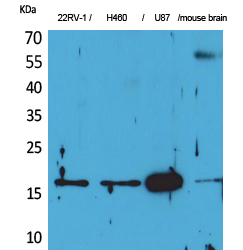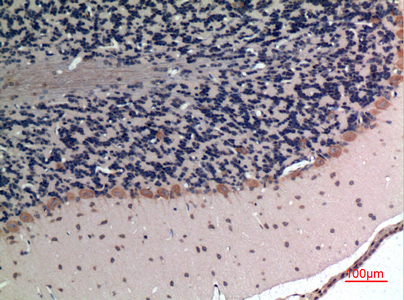Apelin Polyclonal Antibody
- 产品详情
- 实验流程
- 背景知识
Application
| WB, IHC-P |
|---|---|
| Primary Accession | Q9ULZ1 |
| Reactivity | Human, Mouse, Rat |
| Host | Rabbit |
| Clonality | Polyclonal |
| Calculated MW | 8569 Da |
| Gene ID | 8862 |
|---|---|
| Other Names | APLN; APEL; Apelin; APJ endogenous ligand |
| Dilution | WB~~Western Blot: 1/500 - 1/2000. IHC-p: 1:100-300 ELISA: 1/20000. Not yet tested in other applications. IHC-P~~Western Blot: 1/500 - 1/2000. IHC-p: 1:100-300 ELISA: 1/20000. Not yet tested in other applications. |
| Format | Liquid in PBS containing 50% glycerol, 0.5% BSA and 0.09% (W/V) sodium azide. |
| Storage Conditions | -20℃ |
| Name | APLN (HGNC:16665) |
|---|---|
| Synonyms | APEL |
| Function | Peptide hormone that functions as endogenous ligand for the G-protein-coupled apelin receptor (APLNR/APJ), that plays a role in cadiovascular homeostasis (PubMed:10525157, PubMed:22810587, PubMed:35817871, PubMed:38428423). Functions as a balanced agonist activating both G(i) protein pathway and beta-arrestin pathway of APLNR (PubMed:22810587, PubMed:38428423). Downstream G proteins activation, apelin can inhibit cAMP production and activate key intracellular effectors such as ERKs (PubMed:22810587, PubMed:35817871, PubMed:38428423). On the other hand, APLNR activation induces beta- arrestin recruitment to the membrane leading to desensitization and internalization of the receptor (PubMed:22810587, PubMed:38428423). Apelin blunts cardiac hypertrophic induction from APLNR on response to pathological stimuli, but also induces myocardial hypertrophy under normal conditions (PubMed:22810587, PubMed:38428423). Apelin-36 dissociates more hardly than (pyroglu)apelin-13 from APLNR (By similarity). Involved in the regulation of cardiac precursor cell movements during gastrulation and heart morphogenesis (By similarity). Has an inhibitory effect on cytokine production in response to T-cell receptor/CD3 cross-linking; the oral intake of apelin in the colostrum and the milk might therefore modulate immune responses in neonates (By similarity). Plays a role in early coronary blood vessels formation (By similarity). Mediates myocardial contractility in an ERK1/2-dependent manner (By similarity). May also have a role in the central control of body fluid homeostasis by influencing vasopressin release and drinking behavior (By similarity). |
| Cellular Location | Secreted {ECO:0000250|UniProtKB:Q9TUI9}. Secreted, extracellular space. Note=Abundantly secreted in the colostrum. Lower level in milk. Decreases rapidly within several days after parturition in milk, but is still detectable even in commercial milk. {ECO:0000250|UniProtKB:Q9TUI9} |
| Tissue Location | Expressed in the brain with highest levels in the frontal cortex, thalamus, hypothalamus and midbrain (PubMed:10617103) Secreted by the mammary gland into the colostrum and the milk |
For Research Use Only. Not For Use In Diagnostic Procedures.
Provided below are standard protocols that you may find useful for product applications.
BACKGROUND
Endogenous ligand for the apelin receptor (APLNR) (PubMed:10525157). Drives internalization of the apelin receptor (By similarity). Apelin-36 dissociates more hardly than (pyroglu)apelin-13 from APLNR (By similarity). Hormone involved in the regulation of cardiac precursor cell movements during gastrulation and heart morphogenesis (By similarity). Has an inhibitory effect on cytokine production in response to T-cell receptor/CD3 cross-linking; the oral intake of apelin in the colostrum and the milk might therefore modulate immune responses in neonates (By similarity). Plays a role in early coronary blood vessels formation (By similarity). Mediates myocardial contractility in an ERK1/2-dependent manner (By similarity). May also have a role in the central control of body fluid homeostasis by influencing vasopressin release and drinking behavior (By similarity).
终于等到您。ABCEPTA(百远生物)抗体产品。
点击下方“我要评价 ”按钮提交您的反馈信息,您的反馈和评价是我们最宝贵的财富之一,
我们将在1-3个工作日内处理您的反馈信息。
如有疑问,联系:0512-88856768 tech-china@abcepta.com.























 癌症的基本特征包括细胞增殖、血管生成、迁移、凋亡逃避机制和细胞永生等。找到癌症发生过程中这些通路的关键标记物和对应的抗体用于检测至关重要。
癌症的基本特征包括细胞增殖、血管生成、迁移、凋亡逃避机制和细胞永生等。找到癌症发生过程中这些通路的关键标记物和对应的抗体用于检测至关重要。 为您推荐一个泛素化位点预测神器——泛素化分析工具,可以为您的蛋白的泛素化位点作出预测和评分。
为您推荐一个泛素化位点预测神器——泛素化分析工具,可以为您的蛋白的泛素化位点作出预测和评分。 细胞自噬受体图形绘图工具为你的蛋白的细胞受体结合位点作出预测和评分,识别结合到自噬通路中的蛋白是非常重要的,便于让我们理解自噬在正常生理、病理过程中的作用,如发育、细胞分化、神经退化性疾病、压力条件下、感染和癌症。
细胞自噬受体图形绘图工具为你的蛋白的细胞受体结合位点作出预测和评分,识别结合到自噬通路中的蛋白是非常重要的,便于让我们理解自噬在正常生理、病理过程中的作用,如发育、细胞分化、神经退化性疾病、压力条件下、感染和癌症。

.jpg)
.jpg)






